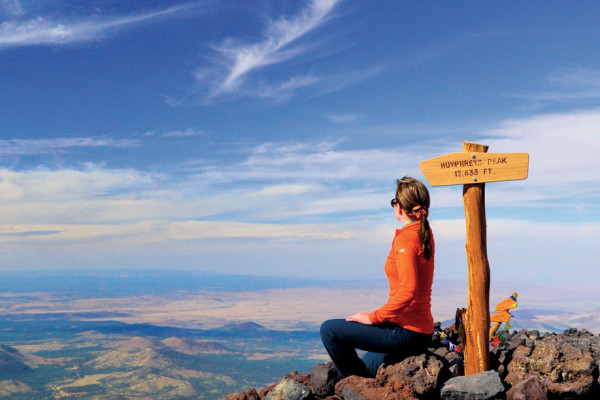Continued (page 2 of 2)
Today, Eugene says only about 5 percent of his work is considered “traditional” sandpainting, though he will include traditional objects such as pottery and baskets in his art. (At the time of our conversation, he was working on a piece called Aura, which was inspired by the migraine headaches that plague him.) Eugene, who signs his pieces Baatsoslanii, which means “he who has many feathers,” considers most of his pieces contemporary and refers to his medium as “sand art.” As the Navajo became more comfortable with the difference between ceremonial sandpaintings and those created as art, the earlier controversy became a thing of the past. “Medicine men use sandpaintings in ceremonies,” he says. “Sand art is a more contemporary form of fine art.” The inspiration for Eugene’s contemporary pieces comes from his imagination and from what he refers to as “the creator.” He doesn’t sketch out his ideas or plan in advance; he says he has the ability to look at a canvas and envision a painting. But he debunks the idea that current Navajo culture frowns on sandpaintings that depict religious ceremonies.
“In the mid 1980s, this distinguished medicine man came up to me – he had all this white hair,” says Eugene. “He looked at my painting, smiled, and asked me why it was off. I told him I changed the designs to protect our religion, and he told me that was good but that it was still important I honor our religion and tradition.” Nowadays, Eugene is more focused on raising his kids, and he teaches workshops and lectures on art in and around Shiprock. Eugene, who has written books on sandpainting, also publishes a yearly periodical, Shiprock Magazine, devoted to the history of Shiprock. And while he’s won his fair share of awards throughout his 50-plus-year career, recognition is the least of his concerns right now. “Each painting is a masterpiece,” he says. “I don’t compete with others. I only compete with myself. Art is a vision that expresses the future and tells a story. My art speaks for me. I don’t need to talk about myself. I will die with sand in my hands.”
See more of Eugene’s work at Blue-Eyed Bear, 299 SR 89A in Uptown Sedona (928-282-1158).
Joe Ben Jr. and Zachariah Ben
Joe Ben Jr. sits in front of a canvas of pale sand, carefully painting a figure using his fingers and blue, black and white pigments. His sons, Frank Miller, 25, and Zachariah Ben, 17, look over his shoulder silently. When Joe finishes demonstrating the Navajo art of sandpainting, he lets us admire his work for a few minutes before he mixes the sand up with his hands, effectively erasing his work. “Now you have to save and preserve it forever in here,” he says, touching his heart. “You house it in your museum.”
Joe, a Navajo medicine man who was born and raised in Shiprock, N.M., creates what he calls ephemeral paintings (like the one he made for us) for healing ceremonies on the Navajo Reservation. During the ceremony, after the painting is complete, the patient sits in the middle of it while the medicine man rubs the sand on the person, which is believed to infuse them with the healing powers of the deities. Just like life, says Joe, the paintings are fleeting. But Joe also creates contemporary fine art sandpaintings that have been collected around the world. (He casually – and without a hint of name dropping – mentions people like Yasser Arafat and Fidel Castro.) Joe believes art is innate. He says when he was a young boy herding sheep he witnessed sandpainting ceremonies. Entranced, he began collecting his own pigments and, when the sheep were settled for a while, he would practice pulverizing the pigments and painting in open areas. His mother, a jewelry maker, recognized his talent, and by the time he was 8, he was participating in ceremonies.
When Joe entered high school, he enrolled in art classes, but he refused to explore any mediums other than sand. His teachers tried to dissuade him. “What galleries are going to carry sand? What museums? That’s what they told me,” says Joe, his gray hair bound at his neck, his brown eyes focused intently on whoever is speaking to him. “They were telling me that to be a legitimate artist, I had to put aside my language because my art is my language. I had to put aside being Navajo. I refused.”
Joe wound up traveling the world, exhibiting his work and teaching in exotic locales like Paris, Morocco, New Delhi and Brazil. While exploring France, he was inspired by the Paleolithic cave paintings of Lascaux. Joe began collecting pigments from France, and he brought the colors back to the reservation. When he started to paint with the pigments, the Navajo people were surprised by the hues; they asked him what mountain the pigments came from. He explained he had to cross a large body of water to collect the pigments, and this instantly ruffled feathers among those who believed pigments used in sandpainting should only come from the four sacred mountains of the Southwest: Blanca Peak and Hesperus Peak in Colo., Mount Taylor in N.M. and the San Francisco Peaks near Flagstaff. “I consulted a medicine man, and he told me [I] was correct,” says Joe. “It was as if I were picking up sand from behind my mother’s back and painting. I was enlightening the subconscious of my community. I broke the barriers of the four sacred mountains.”
Joe continues to use pigments from all over the world in his paintings, a tradition he’s passed down to his son, Zachariah, who is also studying to be a medicine man. Joe’s other son, Frank, builds the foundation and the framework for his father and brother’s paintings, primarily using masonite. This has been an important shift in Joe’s life. While he was traveling the world, soaking up the “glitz and glamour” as he likes to say, someone asked him if he was teaching his children the art of sandpainting. This caused him to pause and reconsider his life’s direction. But it was a Scottsdale gallery owner who sealed the deal. The late Lovena Ohl purchased numerous paintings from Joe and was one of his biggest supporters. Joe asked Lovena how he could ever repay her for her support, and she told him to teach.
Joe turns to his sons and smiles, tears in his eyes. “So we are here today because of the advice from an old white lady,” he laughs. “My life has really come around.” Joe returned to Shiprock where he paints, farms, leads ceremonies and home-schools his sons with the help of his wife, Michelle. He paints every day and feels strongly about creating his own pigments so that he is involved in every aspect of each painting. It’s clear his paintings are very personal, but he doesn’t get attached. “When I’m done, the right person comes forth because the painting was meant to go to someone else,” he says. “My paintings are universal. But what I’m creating isn’t meant to go into a cabinet as a curiosity. It’s a piece of contemporary fine art.”
While Joe talks about his rich life and the enormous influence he’s had on the art of sandpainting, his wife and sons sit silently beside him, listening with a level of respect not common in most families. Zachariah brings out his own work, but he’s quiet to the point of being shy…until his father leaves the room.
“I see sandpainting from a different spiritual perspective,” he says, his face lighting up as he explains a painting he created showing his brother and little sisters dancing at dawn. “My father says sandpaintings are landing strips for the deities, but I think that we are also landing strips for the deities. They come to us, and we go to them.” Zachariah entered his first juried competition last year, and he won first place in his division. He has plans to enter the Heard Museum Guild Indian Fair & Market and the Southwestern Association for Indian Arts’ Santa Fe Indian Market in 2014. He has been teaching classes since he was 12, and he is actively involved in a dance group. But it’s interesting to hear a 16-year-old talk about what he’s trying to achieve with his paintings in today’s technology-obsessed world where teens everywhere have smart phones glued to their fingers. “I like to go to bazaars in the community and sell my small pieces at good prices so I can give back to my people,” he says. “I take memory pictures, and then reinterpret what I saw and put it into a painting. When you use a camera, you turn off a tool that’s inside you. A camera doesn’t let you experience the moment. My paintings reflect what I was feeling in that moment.”
See more of Joe and Zachariah’s work at Hoel’s Indian Shop, 9589 SR 89A in Oak Creek Canyon (928-282-3925)
MORE NATIVE AMERICAN ARTISTS: Navajo silversmiths, Hopi katsina carvers, Acoma potters, Navajo weavers, Hopi potters, jewelers and basket makers, Zuni jewelers and a stone-fetish carver



